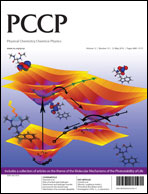High-resolution electronic spectra of indole (C8H7N) and their detailed analysis are reported. Thirteen low-lying vibronic bands—from the electronic origin transition at 35 231.4 cm−1 up to 1000 cm−1 above—are recorded with rotational resolution. Besides inertial parameters and inertial defects these spectra yield detailed information, for each individual band, on the transition-dipole-moment orientations in the molecular inertial frame as well as on the reorientation of that inertial frame upon electronic excitation. The natural lifetimes of the individual vibronic states have also been determined. Strongly varying orientations of the transition-dipole-moments, unexpected positive inertial defects, and decreasing lifetimes, which are only partly related to increased excitation energy, are observed. These results are clear indications of the interaction of the two lowest electronically excited singlet states (1Lb and 1La). Our experimental findings are strongly supported by, and in excellent agreement with, the theoretical description of the interaction of the two electronic states described in the preceding paper. These results provide clear evidence for strong vibronic coupling of the two electronic states 1Lb and 1La and for the energetic location of the 1La-state more than 1000 cm−1 above the 1Lb vibrationless state.
231.4 cm−1 up to 1000 cm−1 above—are recorded with rotational resolution. Besides inertial parameters and inertial defects these spectra yield detailed information, for each individual band, on the transition-dipole-moment orientations in the molecular inertial frame as well as on the reorientation of that inertial frame upon electronic excitation. The natural lifetimes of the individual vibronic states have also been determined. Strongly varying orientations of the transition-dipole-moments, unexpected positive inertial defects, and decreasing lifetimes, which are only partly related to increased excitation energy, are observed. These results are clear indications of the interaction of the two lowest electronically excited singlet states (1Lb and 1La). Our experimental findings are strongly supported by, and in excellent agreement with, the theoretical description of the interaction of the two electronic states described in the preceding paper. These results provide clear evidence for strong vibronic coupling of the two electronic states 1Lb and 1La and for the energetic location of the 1La-state more than 1000 cm−1 above the 1Lb vibrationless state.

You have access to this article
 Please wait while we load your content...
Something went wrong. Try again?
Please wait while we load your content...
Something went wrong. Try again?
 231.4 cm−1 up to 1000 cm−1 above—are recorded with rotational resolution. Besides inertial parameters and inertial defects these
231.4 cm−1 up to 1000 cm−1 above—are recorded with rotational resolution. Besides inertial parameters and inertial defects these 

 Please wait while we load your content...
Please wait while we load your content...